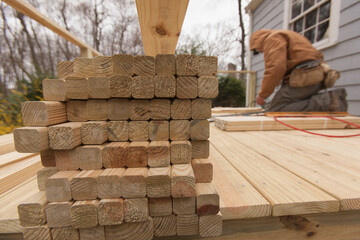
Outdoor spaces have become an extension of the home, and one of the most effective ways to maximize these areas is by adding a well-designed deck. A deck provides a perfect spot for entertaining, relaxing, or simply enjoying the outdoors. Behind every functional and beautiful deck is the expertise of professional deck builders. Their skills, knowledge, and craftsmanship can turn an ordinary backyard into a stylish retreat that enhances both property value and quality of life.
The Importance of Professional Deck Builders
Building a deck may seem straightforward, but it involves more than laying down planks of wood or composite material. It requires careful planning, knowledge of structural integrity, attention to detail, and an understanding of outdoor design. Professional deck builders combine technical expertise with creativity, ensuring that every deck is safe, durable, and aesthetically pleasing.
Hiring experienced builders helps avoid costly mistakes and ensures the deck meets safety standards, withstands outdoor conditions, and complements the overall design of your home.
Benefits of Hiring Deck Builders
Expert Craftsmanship
Deck builders bring years of experience to every project. They know how to properly measure, cut, and install materials, ensuring the deck is not only attractive but also structurally sound.
Custom Design Options
Every homeowner has different needs and preferences. Whether you want a multi-level deck, a wraparound style, or a simple platform design, professional builders can customize plans to match your vision and lifestyle.
Knowledge of Materials
Deck builders are familiar with a wide variety of materials, including wood, composite, and PVC. They can recommend the best option based on your budget, maintenance preferences, and design goals.
Safety and Compliance
Proper deck construction must adhere to building codes and safety guidelines. Professionals ensure your deck meets all requirements, providing peace of mind for you and your family.
Long-Term Value
A professionally built deck lasts longer and requires less maintenance over time. Quality construction reduces the risk of repairs and increases the overall value of your home.
Popular Deck Designs
Deck builders can bring countless styles to life. Some of the most common designs include:
- Platform decks – Simple and cost-effective, ideal for level yards.
- Raised decks – Perfect for homes with uneven terrain, offering elevated views.
- Multi-level decks – Great for large spaces, adding dimension and functionality.
- Wraparound decks – Expansive designs that extend outdoor living around multiple sides of a home.
- Covered decks – Providing shade and protection, allowing outdoor enjoyment in any weather.
Each design can be tailored with features such as built-in seating, railings, lighting, and planters, making the deck both practical and inviting.
Materials Commonly Used by Deck Builders
The choice of material plays a major role in the look, durability, and maintenance of a deck. Professional deck builders help homeowners choose the right option for their specific needs.
- Wood – A classic choice, offering natural beauty and a timeless appearance. Pressure-treated wood and hardwoods like cedar or redwood are popular options.
- Composite – Made from a blend of wood fibers and plastic, composite decking is low-maintenance and long-lasting.
- PVC – Fully synthetic, resistant to moisture, and available in various colors and finishes.
- Aluminum – Lightweight, strong, and highly durable, though less common in residential projects.
Selecting the right material ensures that the deck remains functional and attractive for years to come.
The Deck Building Process
Deck builders follow a structured process to deliver high-quality results.
- Consultation and Planning – Discussing your vision, budget, and design preferences.
- Design Phase – Creating blueprints and 3D models to visualize the final deck.
- Site Preparation – Clearing the area, leveling the ground, and setting foundations.
- Construction – Installing the frame, deck boards, railings, and any additional features.
- Finishing Touches – Applying sealants, stains, or paints to protect the deck and enhance its appearance.
This step-by-step approach ensures precision, durability, and a deck that matches your expectations.
Enhancing Decks with Additional Features
Deck builders can customize projects with features that add both beauty and functionality:
- Built-in seating and storage – Maximizes space and creates a streamlined look.
- Outdoor kitchens or grills – Perfect for entertaining.
- Pergolas or canopies – Provide shade and style.
- Lighting – Extends usability into the evening while improving safety.
- Railings and balusters – Enhance safety and add design flair.
These enhancements transform a standard deck into a personalized outdoor living area tailored to your needs.
Maintenance Tips for Long-Lasting Decks
Even the best-built decks require some level of maintenance to remain in top condition. Professional deck builders often provide guidance on proper care.
- Regularly clean the surface to prevent mold and mildew buildup.
- Inspect railings, boards, and fasteners for signs of wear or damage.
- Apply sealant or stain every few years, especially for wood decks.
- Trim nearby trees and shrubs to prevent excessive moisture exposure.
- Avoid dragging heavy furniture to reduce surface scratches.
Consistent maintenance keeps your deck safe, attractive, and functional for years.
Why Deck Builders Add Value to Your Home
A well-designed and professionally built deck can increase property value significantly. Buyers appreciate the added living space and the potential for outdoor entertaining. More than just a functional structure, a deck becomes an extension of the home, creating a seamless transition between indoor and outdoor areas.
Homeowners who invest in professional deck builders not only enjoy an upgraded lifestyle but also benefit from a strong return on investment when it comes time to sell.
Deck builders play a crucial role in creating outdoor spaces that are both beautiful and practical. Their knowledge, craftsmanship, and design expertise ensure that every deck enhances property value, improves lifestyle, and stands the test of time.
From planning and design to construction and finishing touches, professional deck builders transform ideas into reality. Whether you want a cozy retreat, a space for entertaining, or an elaborate multi-level design, their expertise ensures your outdoor vision comes to life with style and durability.
